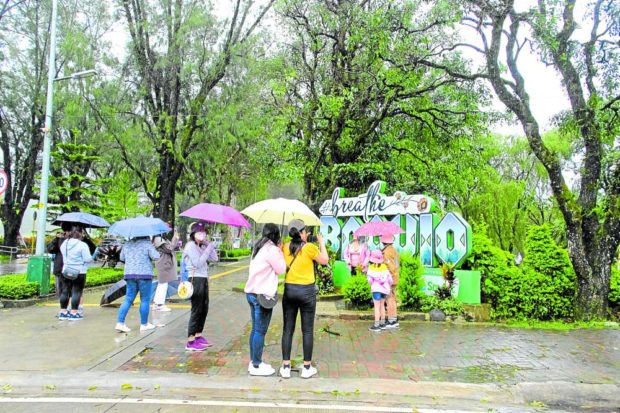
RAIN OR SHINE | Despite the howling winds and rains spawned by Severe Tropical Storm “Paeng” (international name: Nalgae), some weekend tourists still turn up and wander around Burnham Park on Sunday. Tourism is a key economic driver in the summer capital that has since seen a rise in mixed-use real estate development projects mostly initiated by local builders. (Photo by NEIL CLARK ONGCHANCO)
BAGUIO CITY, Benguet, Philippines —Baguio builders are stepping up to help the city and the Cordillera economies recover, given the threats posed this year by global inflation, public and private housing officials said at a housing summit here last week.
Ferdinand Tiong, chapter president of Chamber of Real Estate and Builders’ Association, said every project now being undertaken by local developers generated new jobs and public spending, which will drive the economy and “help the less fortunate.”
As many as 39,660 Cordillera residents (or about 11,800 households) were classified as subsistence poor “or food poor” in 2021, and would require the most help now that prices of commodities and services for the past nine months have escalated. The value of the peso in the highlands is equivalent to 79 centavos as of August 2021. The peso also continues to weaken against the US dollar.
“Food poor” is the population with incomes that are below the food threshold. They are unable to “buy their basic food needs and satisfy the nutritional requirements set by the Food and Nutrition Research Institute to ensure that one remains economically and socially productive,” according to the Philippine Statistics Authority (PSA).
But while “22 out of 1,000 Cordillerans were food poor” in 2021, the number of the region’s poor actually dropped despite the impact of the coronavirus pandemic on the region’s gross regional domestic product, said Aldrin Bahit Jr., PSA senior statistician for the Cordillera, during an Oct. 7 economic briefing here.
He said last year’s poverty incidence in the highland provinces of Apayao, Abra Ifugao, Kalinga, Benguet and Mountain Province was estimated at 6.9 percent. That means seven out of every 100 Cordillera families “have incomes that were not sufficient to buy food and other basic necessities,” he said. Families are classified as poor if their monthly income is lower than the Cordillera poverty threshold of P11,793 which is the adequate minimum earning in mountain communities that is sufficient to buy a family’s basic needs.
Cordillera poor
The latest Cordillera figure was an improvement compared to its 8.6-percent poverty incidence in 2018 (or when about nine out of every 100 Cordillerans were poor) and 17.1 percent in 2015 (when 17 out of every 100 Cordillerans were poor). As a result, Ifugao, Kalinga, Apayao and Benguet are now counted among the country’s least poor provinces.
Most businesses were shuttered in 2020 when the coronavirus pandemic broke out, so 2021 was when developers resumed operations, said Tiong, the president of Megapines Realty and Development Inc. that has constructed six condominium projects in Baguio.
The 2020 lockdown and quarantines left the region with a negative 10-percent growth, but Cordillera economy soared to 7.5 percent in 2021 once restrictions on movement and business operations were eased.
“We had to absorb our losses and continue ongoing projects or begin the process for future constructions. We couldn’t stop because ceasing projects would not only affect us and our employees, but the rest of the economy,” Tiong said.
Housing backlog
The government is currently pouring fresh resources to reduce a Cordillera housing backlog of about 30,000 to include 678 families in Abra, the epicenter of the July 27 earthquake, who lost their homes, said Maria Amoroso, Cordillera director of the Department of Human Settlements and Urban Development (DHSUD).
Amoroso said DHSUD has released housing aid to the Abra quake victims and has targeted 10,000 comfortable homes which the government intends to raise between 2022 and 2023, most of which are within BLISTT (a new metropolis composed of Baguio City and the Benguet towns of La Trinidad, Itogon, Sablan, Tuba, and Tublay).
Baguio alone has a 15,000 housing backlog based on a new inventory, she said. The city government has launched a model for low-cost housing called the Luna Terraces, Amoroso said.

